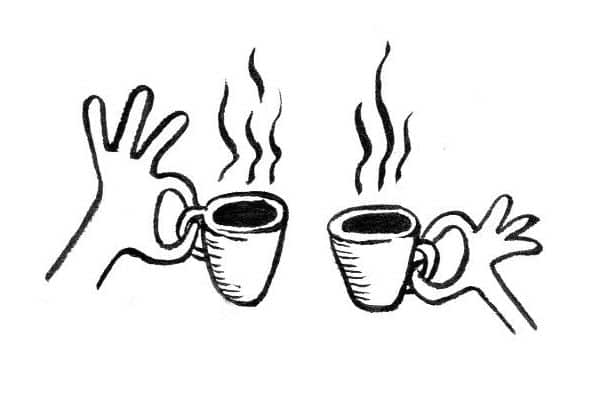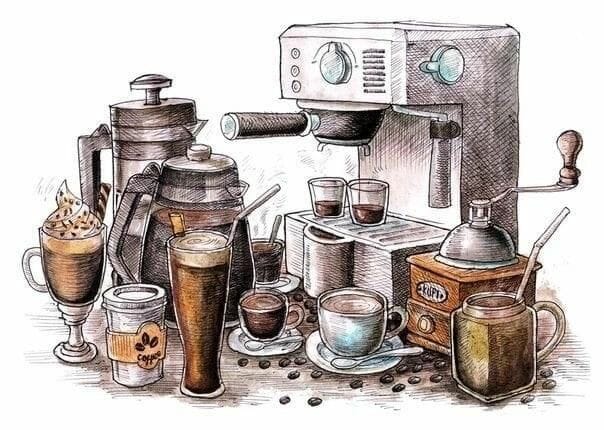The inside of an espresso machine is a veritable jungle of metal, wires, and steam. You may be surprised to learn this, but underneath the bells and whistles, most espresso machines do the same thing: force hot water through finely-ground coffee.
So how does an espresso machine work? And what is the quickest, most painless way to understand how they function without getting lost in the mechanical thick? In this Son of a Barista guide, we’ll show you how espresso machines work by following water as it goes from the source to the coffee.
The water
To get closer to answering our question: “how does an espresso machine work?”, we will start at the back of the machine and work our way forward. We will start at the water source.
Every espresso machine needs water to function. For home espresso machines, water enters from one of two sources: a reservoir located in the machine or a plumbed connection to a consistent water supply. Often, the water source is determined by how the machine will be used. For instance, machines that are designed to produce only a handful of high-quality espressos and lattes daily are usually fitted with reservoirs like your Son of a Barista coffee machine.
The benefit of a reservoir is that you can easily dial in the water quality and are not beholden to starting with what comes out of the tap. High-quality water filtration pitchers can do a terrific job of conditioning water.
The pump
Moving forward in answering our question “how does an espresso machine work?”, we will now move to the pump.
To give water the strength to push through a tightly packed bed of finely ground coffee, say your puro coffee pod with 100% arabica beans, machines need pressure: 9 bars of pressure to be exact.
Fun fact: Some of the first espresso machines used pistons attached to large levers. Baristas would have to manually pull these levers to force the water to pass through the coffee (hence the term pull an espresso).
In home espresso like your Son of a Barista coffee machine, there are two categories of electric pump: the vibratory pump and the rotary vein pump.
Vibratory pump
A vibratory pump, or vibe pump, is a small electromagnetic workhorse. A piston attached to a magnet is set inside a metal coil. Electrical current runs through the coil causing the magnet to rapidly move the piston back and forth, pushing water through the machine. Your average vibe pump clocks in at sixty pushes per second.
Rotary pump
Unlike a vibratory pump, a rotary pump is mechanical and is the pump that your Son of a Barista coffee machine uses. It is also a complex mechanism. A motor spins a disc that is offset inside a large, round chamber. The spinning disc is segmented into sections by veins. As the disc spins, the veins press against the wall of the outer chamber, diminishing the size of the section, creating pressure. Water enters in during the large phase and is pushed out as the section shrinks.
Rotary pumps, like the one in your Son of a Barista coffee machine, are quieter, offer more consistent pressure, and generally have a longer lifespan.
The boiler
We are almost at the end of answering “how does an espresso machine work?”. Our last stop is the boiler. Water needs to be both pressurized and heated to turn the organic coffee in your Son of a Baritsa coffee pod into a brilliant espresso. The boiler is where a machine adds heat.
The basic function of a boiler is to heat and hold the pressurized water coming from the pump. The earliest espresso machines would use wood fire. Modern machines use electric heating elements to bring the water to temperature. If you set a hotter temperature, it’ll result in higher extraction yields (and burnt coffee).

Setting the right temperature
For all the intensity of pressure and heat, making espresso is a delicate art; even small changes in water temperature can drastically affect the quality of your shot. The optimal temperature for espresso extraction is 96°C (205°F) which is the exact temperature that your Son of a Barista coffee machine is set to.
Many outside factors can interfere with the temperature of your espresso shot. Factors such as:
1. The temperature of your coffee pod
If your coffee pod is stored in an air conditioned room or a cold place, the coffee inside it will be cold and therefore be harder to heat to the proper temperature. Make sure to store your coffee pods in a temperate place.
2. The temperature of your espresso cup
A pro barista tip for overcoming your cold espresso cup is to press the button on your Son of a Barista coffee machine and let hot water fill your cup to heat it. You can also turn on your faucet and place the cup under warm water until it’s nice and warm.
3. The mass of your espresso shot
Once your espresso shot is in your cup its small mass loses heat quicker than let’s say a larger cup of tea. To prevent the espresso from loosing its perfect temperature, make sure to enjoy your espresso right away after brewing it.
Where did the espresso machine come from?
Now that we’ve answered the question “how does an espresso machine work” it’s time to look at where the espresso machine came from. The answer to that question is one that makes the Son of a Barista very proud because it just so happens that the espresso machine comes from Italy!
Espresso is not a blend, bean, or roast. Espresso is the type of brew that results from water at the correct temperature flowing through finely-ground coffee at the perfect pressure to create the ideal ounce (30 ml) of espresso deliciousness. Heating the water to the ideal temperature and applying the correct pressure is no small feat.

The first espresso machine
To trace the humble beginnings of the espresso machine, you have to go all the way to the 19th century in Turin, Italy, and find a man named Angelo Moriondo. He wasn’t the first person to try his hand at creating espresso, but his design would be patented and then copied by many who would enhance his original idea. Moriondo’s machine would be the first to use water and steam through coffee grounds for a perfect brew.
Following the work of Moriondo were two men named Luigi Bezerra and Desiderio Pavoni. They would improve and spread Moriondo’s original design. Bezerra invented the single-shot espresso in the early 20th century. He added pieces like the portafilter, multiple brew heads, and many other features that are still used today. He knew the coffee side of things, but he didn’t know how to expand his business or ideas. Even if he knew how he didn’t have the money to finance such a venture, that’s when Desiderio Pavoni stepped in.
Pavoni bought Bezzera’s patents and would market their brand. With his knowledge, the business name would spread, but he wasn’t without coffee knowledge. He invented the pressure release valve, which proved very useful since it meant that baristas would not be splashed by hot coffee. He would also add the steam wand. Both men would work together to build their first espresso machine called the Ideale and would enter it in the 1906 Milan Fair.
Espresso is first introduced to the world
For the first time, they introduced the cafe espresso to the world. The word espresso has Italian roots meaning “made in the spur of the moment.” It would be the first time people enjoyed an espresso shot made quickly to order. Following the Milan fair, espresso machines started to pop up.
Even with all the work they put in, the espresso shots weren’t the best, and they didn’t spread too far beyond the region of Milan. Pavoni would have a stronghold in that market for a long time, but machines were difficult to operate, would rely primarily on steam, and couldn’t quite get beyond the 1.5-2 bars of pressure without burning the coffee. To give you context, modern espresso machines reach nine bars of pressure when you’re pulling espresso shots.
The invention of the automatic espresso machine
Then came Francisco Illy, who would invent the first automatic coffee maker using compressed air instead of steam. This machine provided a more stable result but would still not reach the necessary bars of pressure to make the best espresso shot. There appeared to be no way to get beyond the barrier of two bars of pressure.
Along would come Giovanni Achille Gaggia. He would break the barrier that no one could. His machine could reach 8-10 bars of pressure. So many things that we know today came from Gaggia’s machines. His device would standardize the one-ounce output of an espresso shot.
Crema is discovered
A discovery was made once the machine reached 8-10 bars of pressure; a gold-like foam would form, which we know now as the crema. The crema was undiscovered until Gaggia and his espresso machines reached the levels of pressure required.
The pump is invented
Around 1950, the invention of the pump by Ernest Valente would improve the espresso machine even more. The pump’s main feature was an even flow of water that was allowed to flow through the coffee continuously. Espresso machines would continue to improve, but about ten years after Gaggia had perfected the pressure problem, a significant shift would come; the semi-automatic espresso machine. Once the invention of the semi-automatic machine took place, espresso began to explode all over the world.
Espresso machines today
It was a company by the name of Faema that would offer the first semi-automatic espresso machine in 1961. And like previous coffee makers, Faema was in Milan. It worked with a pump, and cold water could go directly into the machine to heat it quickly. It was easy to use and compact. Coffee shops with narrow spaces could easily use it, and it was simple to learn. With the improved simplicity of the semi-automatic, you started to see a rise in smaller espresso machines being built for home use just like the Son of a Barista coffee machine.
Starting with Moriondo to Gaggia, we enjoy delicious espresso drinks because of their passion for creating the perfect espresso. If it wasn’t for them, coffee might not be what it is today. And, if there’s a country we should thank, it’s Italy. It has undoubtedly left its mark on the coffee-loving world.





8 thoughts on “How does an espresso machine work? ”
Thanks for the chance to win..
Love this, very informative
I have always been curious about the history of the espresso machine. This was very informative!